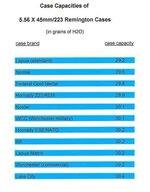- Messages
- 555
- Reactions
- 606
Tell me your thoughts on the case capacity of the 5.56 vs .223. I've always heard/read to start at 10% less with you load, when loading a military 5.56 case. I've been loading a while, 40yrs + and have always loaded by this rule. Now, a couple of guys i know who have been loading maybe 4 months, tops, are trying to tell me, they read in a loading manual there is no difference between the Mil 5.56 and the .223 commercial case capacity. I've made it all these years with all 1o fingers, and both eyes, and i don't plan on changing my loading habits. I was just wondering what you think. Heavy mil spec brass vs, commercial brass is the issue. From my point of view they can load it how ever they feel safe loading it. They like to load around max loads, or push it as far as they can with commercial brass in .223












